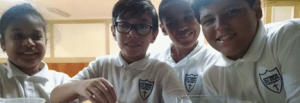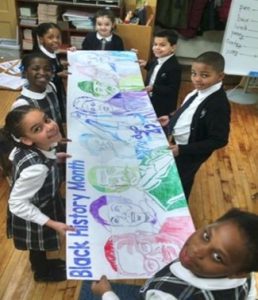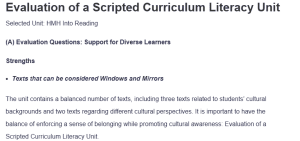Evaluation of a Scripted Curriculum Literacy Unit
Selected Unit: HMH Into Reading
(A) Evaluation Questions: Support for Diverse Learners
Strengths
- Texts that can be considered Windows and Mirrors
The unit contains a balanced number of texts, including three texts related to students’ cultural backgrounds and two texts regarding different cultural perspectives. It is important to have the balance of enforcing a sense of belonging while promoting cultural awareness: Evaluation of a Scripted Curriculum Literacy Unit.
- Opportunities to make connections to the background knowledge and interests of the children in my class
Activities for activating background knowledge are provided in the unit and can be used with texts such as Windows. For instance, before reading a story about another culture, the unit includes discussions about cultural traditions in accordance with the idea of the importance of celebrating students’ various experiences, as advocated by Souto-Manning and Martell (2016).

Weaknesses
- Opportunities to differentiate lessons to adequately challenge and support all the children in my class
The unit presents some differentiated activities, but many lessons present little variation in their approach and may not be sufficiently challenging for more able or sufficient support for weaker learners. Lack of differentiation can undermine engagement and even outcomes for diverse learners.
- Opportunities provided by the unit to incorporate learning preferences
Two characteristics of the unit that limit use across learners are direct instruction and text-based activities. However, by including activities that incorporate more kinesthetic or tactile activities, such as role plays or hands-on projects, students with a range of learning preferences will be more likely to be engaged.
Characteristics of the Children
The St. Simon Stock School has a diverse second-grade class populated by students from many different cultural, linguistic, and socio-economic backgrounds. Visual aids and culturally relevant texts are good for many students because so many of them are English Language Learners (ELLs). For instance, I introduced a story by lesson about a holiday of another culture, and it helped students to relate their experiences as it increased engagement.
In addition, some students are provided with special education services for which differentiated instruction needs to be implemented in order to meet the learning needs of these students. The diversity of learners means that the curriculum must be flexible and inclusive, which involves group discussions in which students share personal stories with each other and learn from one another.
(B) Lesson Adaptation Proposal
Selected Lesson: “Exploring Cultural Traditions”
Recommendation 1: Incorporate Visual and Kinesthetic Learning
- Explanation: The class is filled with many visual and kinesthetic learners who like hands-on activities. Throughout the lesson, the more inclusive part could be incorporated by using visual aids such as pictures or videos of cultural traditions or by engaging students in kinesthetic activities such as cultural dance or crafts.
- Implementation: Students could use the text about a cultural tradition they have been introduced to so as to participate in a craft activity to create a representation of that tradition. This hands-on approach lets the students present what they know creatively and make the lesson content stick.

Recommendation 2: Use Collaborative Learning Strategies

- Explanation: Collaborative learning can be one way in which students with diverse backgrounds can become engaged and understood. Group discussions and projects allow students to learn from each other and understand others’ perspectives. Notably, such learning promotes a community.
- Implementation: After reading the text, students could be organized into small groups to discuss their cultural traditions. Each group can present their findings to the class, giving peer learning and value to each one of our students’ backgrounds. This corresponds to the inclusive teaching directed by Souto-Manning and Martell (2016).
References
Souto-Manning, M., & Martell, J. (2016). Reading, writing, and talk: Inclusive teaching strategies for diverse learners, K-2. Teachers College Press.
ORDER A PLAGIARISM-FREE PAPER HERE
We’ll write everything from scratch
Question 
Evaluation of a Scripted Curriculum Literacy Unit (5 points)
(A) Pick one unit in a scripted literacy curriculum used in New York City Public Schools (HMH Into Reading, Imagine Learning EL Education, or Great Minds Wit & Wisdom) at the grade level of your fieldwork placement or a grade level close to your fieldwork placement and evaluate it using the following two questions.
- In what ways does this unit do a strong job of supporting/engaging diverse learners?
- In what ways does this unit not do a strong job of supporting/engaging diverse learners?
Make sure to address four of the following points when answering these two questions:

Evaluation of a Scripted Curriculum Literacy Unit
- How many texts in the unit can be considered windows and how many texts can be considered mirrors for the children in your class? Does the unit provide opportunities/ways to build your children’s background knowledge for texts that are windows?
- Does the unit provide opportunities/ways to differentiate lessons to adequately challenge and support all the children in your class? If so, could these be improved and how?
- Does the unit provide opportunities/ways to incorporate each of the following learning preferences: visual, auditory, kinesthetic, tactile, and social? (For social, you are considering whether some lessons in the unit provide opportunities for group work and/or group discussions.) If so, could these be improved and how?
- Does the unit provide open-ended questions that will encourage your children to respond in thoughtful ways, and possibly engage in interactive discussions? If so, could these be improved and how?
- Does the unit provide opportunities/ways to make connections to the background knowledge and interests of the children in your class? Could these be improved and how?
- Does the unit provide opportunities/ways for the children in your class to engage in vocabulary in a variety of ways, including using more than one modality and/or language? Could these be improved and how?
- Does the unit provide opportunities for your children to engage in extension activities after reading a text that could help them better understand the texts? Could these be improved and how?
- Does the unit provide opportunities to engage in authentic learning and/or to use the community as a learning resource? Could these be improved and how?
- Did you identify any other way that the unit is supportive or not supportive of the children in your classroom?
(In answering these questions, make sure to include the characteristics of the children in your class that are pertinent to the points you are making in the evaluation, making specific note of diversity. Make sure to include examples from various lessons in the unit to substantiate your evaluations.)